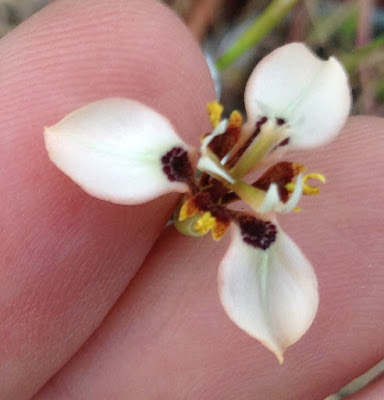This is a "variable species," which I've learned is a polite way of saying that when a non-botanist looks at it they'll say "there's no way those things are the same species." Dr. Goldblatt explains in his Moraea book that there are so many intermediate variations within the range of M. unguiculata that there's no way to draw the line between them. Who am I to argue?
As of 2024, I've bloomed three forms of M. unguiculata. The first one, from Rareplants.de, is this little jewel, tiny as a fingertip:
So far I haven't been able to cross it with any of the Peacock Moraeas.
My second M. unguiculata form came from Silverhill Seed. They reported that it grows native in the Koue Bokkeveld, a mountainous inland area of South Africa.
These photos came out with a greenish cast to them because of the lighting at the time; in reality the flowers are creamy white. And as you can see, they're a lot larger than the first form.
M. unguiculata blooms at the end of April here in California, about a month after the peak of most winter-growing Moraeas. I have not been able to hybridize the first form with any of my other species, but the second form set seeds when crossed with M. loubseri and M. villosa in 2018. Those crosses have started to bloom and are definitely hybrids. The loubseri cross can be seen here.
I'm interested in obtaining other forms of M. unguiculata. Even if they're all technically the same species, each is interesting in its own right, and I'm curious to see what they'll do in hybrids.
I'm interested in obtaining other forms of M. unguiculata. Even if they're all technically the same species, each is interesting in its own right, and I'm curious to see what they'll do in hybrids.









No comments:
Post a Comment
Due to spam, I am now requiring moderation for comments on most posts. I apologize if your comment does not appear immediately; I will approve it as soon as I can.